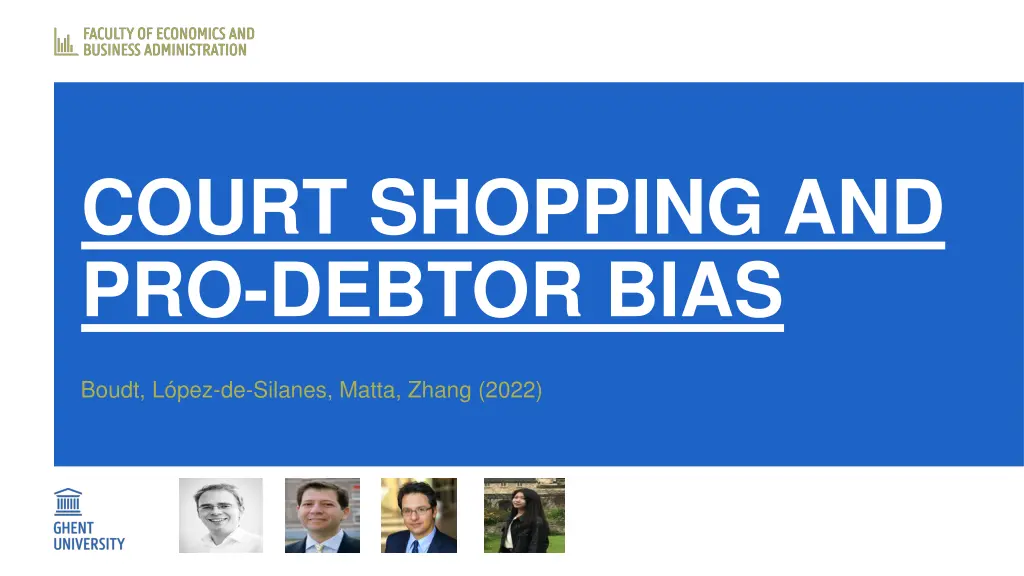
Strategic Insights into Court Shopping in Bankruptcy Cases
Explore the strategic maneuvers and biases in bankruptcy cases, including the impact of Chapter 11, court shopping tactics by firms, and the influence of judges on pro-debtor decisions. Discover how the dynamics between debtors, creditors, and judges shape outcomes in the bankruptcy process.
Uploaded on | 1 Views
Download Presentation

Please find below an Image/Link to download the presentation.
The content on the website is provided AS IS for your information and personal use only. It may not be sold, licensed, or shared on other websites without obtaining consent from the author. If you encounter any issues during the download, it is possible that the publisher has removed the file from their server.
You are allowed to download the files provided on this website for personal or commercial use, subject to the condition that they are used lawfully. All files are the property of their respective owners.
The content on the website is provided AS IS for your information and personal use only. It may not be sold, licensed, or shared on other websites without obtaining consent from the author.
E N D
Presentation Transcript
COURT SHOPPING AND PRO-DEBTOR BIAS Boudt, L pez-de-Silanes, Matta, Zhang (2022)
QUESTIONS? Imagine you are a manager of a company located in the United States, and you face the financial troubles that you can not fulfil all your financial obligations. What can you do if you want to stay in business? Chapter 11 - reorganization bankruptcy 2
QUESTIONS? Do you think the Chapter 11 is a fair game for debtors and creditors of the large companies? 3
LoPucki (1983) argues that the bankruptcy process is biased in favour of preserving businesses that are economically distressed and should be liquidated immediately. Obviously, large companies tend to prefer a bankruptcy court over others when the bankruptcy judges can give the debtors what they want to achieve. LoPucki (2010) LoPucki (2010) describes how judges compete for large cases to generate millions of dollars in fees for local lawyers, gain reputation and have better post-judicial employment or post-retirement business opportunities. 4
DOES IT MATTER? LoPucki and Whitford (1992) claim that high refiling in bankruptcy is a failure to the Chapter 11. Chang and Schoar (2013) find that Chapter 11 assigned to pro-debtor judges leads to lower rates of firm survival (probability of refiling the bankruptcy) and lower sales and employment growth. 5
STRATEGIC BEHAVIOR OF THE FIRM Can firms influence the game? Yes: court shopping Options of the court shopping The US Code Title 28 Chapter 87 1408 states that a debtor can file under Chapter 11 in one of the following four locations: (1) the debtor s place of domicile or residence, commonly referred to as the place of incorporation; (2) the debtor s principal place of business; (3) the location of the debtor s principal assets; (4) any district where a bankruptcy case is pending against the debtor s affiliate. 6
STRATEGIC BEHAVIOR OF THE JUDGE Gennaioli and Rossi (2010) state that the probability of the pro-creditor judges make pro-debtor decisions increases when: The judge has more career concern to attract the cases in the future There is a lower cost to court shopping There is less creditor protection in case of reorganization 7
OUR CONTRIBUTION BASED ON LONGITUDINAL ANALYSIS OF CASES Granting Order ??,? Court shopping ? ??? ? ? Pro-Debtor Order ??? Use of cash collateral Sale of assets Extend the exclusivity periods Pro-Creditor Order ??? Case dismissal Convert to Chapter 7 Lift the automatic stay Eq 2) Eq 1) Filing Motions ??,? Pro-Debtor bias ??? Chang, T., & Schoar, A. (2013). Judge specific differences in Chapter 11 and firm outcomes. Unpublished working paper, National Bureau of Economic Research Cambridge ? ?? ?? ? ?? ?? ?- ?? ? ??? 1 3 ?=1 3 ? = ?? ? Logistic modelPro-Debtor ? ??? 1 3 ?=1 ?= 3 ?? ? Refiling the bankruptcy bias ???? ? DMCi = ?? PDi is a binary of DMCi, if DMCi >0 Eq1) Prob [? ???=1, ???=1 |?? ?, ?? ?, ? ?? ?] = 2(? ?? ?+ ? ???, ) where i=1, ,490 firm and j =1, ,3 order Eq2) Prob [??,? =1, ??,? =1, |?? + ???,?+ ?? ??? , ?) ?, ?? ?+ ?? ???, ? ?? ?] = ?2(? ?? ? 8
TAKE HOME POINTS Judicial decision tends to be more pro-debtor biased in the case of a court shopper. The expected probability of granting pro-debtor motions affects motions filing decisions by firms. Bankruptcy courts tend to accept more pro-debtor motions when the cases handled to them are court shoppers. Pro-debtor bias (DMC index) increases the probability of refiling for bankruptcy. 9
THE AVERAGE ATTENTION SPAN DURING A LIGHT TALK IS 6 MINUTES. Email: Shilin.Zhang@Ugent.be Linkedin: www.linkedin.com/in/shilinz 10
